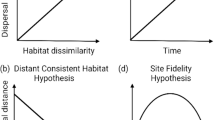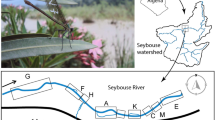Abstract
Understanding the functional significance of shelter for animal populations requires knowledge of the behavioural mechanisms that govern the dynamics of shelter use. Exploitation of shelters may be impeded by mutual interference, yet interference competition can be difficult to distinguish from exploitation competition. We used bullheads (Cottus gobio) as a model system of mobile fish to investigate the effect of intraspecific competition on shelter use. A series of field experiments was conducted under controlled conditions of shelter availability and population density. For each experiment, the location of each individual fish was observed over a period of 10 days. We then constructed a continuous-time Markov-chain model for the movement of fish between shelters and the open stream, which explicitly parameterised exploitation competition and interference competition for shelter and which accounted for two different size-classes of fish. By using a stochastic rather than a deterministic model, we were able to account for the distribution of fish across shelters, and not just the average occupation. Analysis of the model showed strong evidence of exploitation competition, which was highly dependent on body size, and an increased departure rate from shared shelters. Over and above exploitation, interference competition limited the ability of unsheltered fish to colonise vacant shelters at high population densities. Different formulations of the interference competition were compared using the Akaike Information Criterion. The formulation that best fitted the observations modelled interference competition as an increasing function of average shelter occupancy rather than population density per se.


Similar content being viewed by others
References
Akaike, H. (1974). A new look at the statistical model identification. IEEE Transactions on Automatic Control, 19(6), 716–723.
Allouche, S. (2002). Nature and functions of cover for riverine fish. Bulletin Franais de la Pche et de la Pisciculture, 365/366, 297–324.
Armstrong, J.D., & Griffiths, S.W. (2001). Density-dependent refuge use among over-wintering wild Atlantic salmon juveniles. Journal of Fish Biology, 58, 1524–1530.
Baltz, D.M., Moyle, P.B., & Knight, N.J. (1982). Competitive interactions between benthic stream fishes, riffle sculpin, Cottus gulosus, and speckled dace, Rhinichthys osculus. Canadian Journal of Fisheries and Aquatic Sciences, 39, 1502–1511.
Boussu, M.F. (1954). Relationship between trout populations and cover on a small stream. Journal of Wildlife Management, 18, 229–239.
Brown, L.R. (1991). Differences in habitat choice and behavior among 3 species of sculpin (Cottus) in artificial stream channels. Copeia, 1991, 810–819.
Cunjak, R.A. (1988). Behaviour and microhabitat of young Atlantic salmon (Salmo salar) during winter. Canadian Journal of Fisheries and Aquatic Sciences, 45, 2156–2160.
Cunjak, R.A., & Power, G. (1986). Winter habitat utilization by stream resident brook trout (Salvelinus fontinalis) and brown trout (Salmo trutta). Canadian Journal of Fisheries and Aquatic Sciences, 43, 1970–1981.
Davey, A.J.H., Hawkins, S.J., Turner, G.F., & Doncaster, C.P. (2005). Size-dependent microhabitat use and intraspecific competition in Cottus gobio. Journal of Fish Biology, 67, 428–443.
Doncaster, C.P., & Gustafsson, L. (1999). Density dependence in resource exploitation: empirical test of Levins’ metapopulation model. Ecology Letters, 2, 44–51.
Dubs, D.O.L., & Corkum, L.D. (1996). Behavioral interactions between round gobies (Neogobius melanostomus) and mottled sculpins (Cottus bairdi). Journal of Great Lakes Research, 22, 838–844.
Eklv, A.G., & Greenberg, L.A. (1998). Effects of artificial instream cover on the density of 0+ brown trout. Fisheries Management and Ecology, 5, 45–53.
Figler, M.H., Cheverton, H.M., & Blank, G.S. (1999). Shelter competition in juvenile red swamp crayfish (Procambarus clarkii): The influence of sex differences, relative size and prior residence. Aquaculture, 178, 63–75.
Gill, P.E., Murray, W., & Wright, M.H. (1991). Numerical Linear Algebra and Optimization (Vol. 1). Redwood City: Addison Wesley.
Goss-Custard, J.D., Caldow, R.W.G., Clarke, R.T., & West, A.D. (1995). Deriving population parameters from individual variations in foraging behaviour. II. Model tests and population parameters. Journal of Animal Ecology, 64, 277–289.
Greenberg, L.A. (1988). Interactive segregation between the stream fishes Etheostoma simoterum and E. rufilineatum. Oikos, 51, 193–202.
Gregory, J.S., & Griffith, J.S. (1996). Aggressive behaviour of underyearling rainbow trout in simulated winter concealment habitat. Journal of Fish Biology, 49, 237–245.
Gries, G., & Juanes, F. (1998). Microhabitat use by juvenile Atlantic salmon (Salmo salar) sheltering during the day in summer. Canadian Journal of Zoology, 76, 1441–1449.
Griffiths, S.W., & Armstrong, J.D. (2002). Rearing conditions influence refuge use among overwintering Atlantic salmon juveniles. Journal of Fish Biology, 60, 363–369.
Guan, R., & Wiles, P.R. (1997). Ecological impact of introduced crayfish on benthic fishes in a British lowland river. Conservation Biology, 11, 641–647.
Harwood, A.J., Metcalfe, N.B., Griffiths, S.W., & Armstrong, J.D. (2002). Intra- and inter-specific competition for winter concealment habitat in juvenile salmonids. Canadian Journal of Fisheries and Aquatic Sciences, 59, 1515–1523.
Imre, I., Grant, J.W.A., & Keeley, E.R. (2002). The effect of visual isolation on territory size and population density of juvenile rainbow trout (Oncorhynchus mykiss). Canadian Journal of Fisheries and Aquatic Sciences, 59, 303–309.
Kalleberg, H. (1958). Observations in a stream tank of territoriality and competition in juvenile salmon and trout (Salmo salar L. and S. trutta L.). Report Institute of Freshwater Research Drottningholm, 39, 55–98.
Ladich, F. (1989). Sound production by the river bullhead, Cottus gobio L. (Cottidae, Teleostei). Journal of Fish Biology, 35, 531–538.
Lessells, C.M. (1995). Putting resource dynamics into continuous input ideal free distribution models. Animal Behaviour 49, 487–494.
Mills, C.A., & Mann, R.H.K. (1983). The bullhead Cottus gobio, a versatile and successful fish. Freshwater Biological Association Annual Report, 51, 76–88.
Mullen, D.M., & Burton, T.M. (1998). Experimental tests of intraspecific competition in stream riffles between juvenile and adult longnose dace (Rhinichthys cataractae). Canadian Journal of Zoology, 76, 855–862.
Powell, M.J.D. (1978). A fast algorithm for nonlinearly constrained optimization calculations. In G. A. Watson (Ed.), Numerical analysis. Lecture notes in mathematics (Vol. 630). Berlin: Springer.
Rangeley, R.W., & Kramer, D.L. (1998). Density-dependent antipredator tactics and habitat selection in juvenile pollock. Ecology, 73, 943–952.
Saunders, J.W., & Smith, M.W. (1962). Physical alteration of stream habitat to improve trout production. Transactions of the American Fisheries Society, 91, 185–188.
Sloman, K.A., & Armstrong, J.D. (2002). Physiological effects of dominance hierarchies: laboratory artefacts or natural phenomena? Journal of Fish Biology, 61, 1–23.
Smyly, W.J.P. (1957). The life-history of the bullhead or Miller’s Thumb (Cottus gobio L.). Proceedings of the Zoological Society of London, 128, 431–453.
Soderback, B. (1994). Interactions among juveniles of two freshwater crayfish species and a predatory fish. Oecologia, 100, 229–235.
Stillman, R.A., Goss-Custard, J.D., & Caldow, R.W.G. (1997). Modelling interference from basic foraging behaviour. Journal of Animal Ecology, 66, 692–703.
Valdimarsson, S.K., & Metcalfe, N.B. (1998). Shelter selection in juvenile Atlantic salmon, or why do salmon seek shelter in winter? Journal of Fish Biology, 52, 42–49.
van der Meer, J., & Ens, B.J. (1997). Models of interference and their consequences for the spatial distribution of ideal and free predators. Journal of Animal Ecology, 66, 846–858.
Vorburger, C., & Ribi, G. (1999). Aggression and competition for shelter between a native and an introduced crayfish in Europe. Freshwater Biology, 42, 111–119.
Welton, J.S., Mills, C.A., & Rendle, E.L. (1983). Food and habitat partitioning in two small benthic fishes, Noemacheilus barbatulus (L.) and Cottus gobio (L.). Archiv Fr Hydrobiologie, 97, 434–454.
Author information
Authors and Affiliations
Corresponding author
Rights and permissions
About this article
Cite this article
Davey, A.J.H., Doncaster, C.P. & Jones, O.D. Distinguishing Between Interference and Exploitation Competition for Shelter in a Mobile Fish Population. Environ Model Assess 14, 555–562 (2009). https://doi.org/10.1007/s10666-008-9171-5
Received:
Accepted:
Published:
Issue Date:
DOI: https://doi.org/10.1007/s10666-008-9171-5




